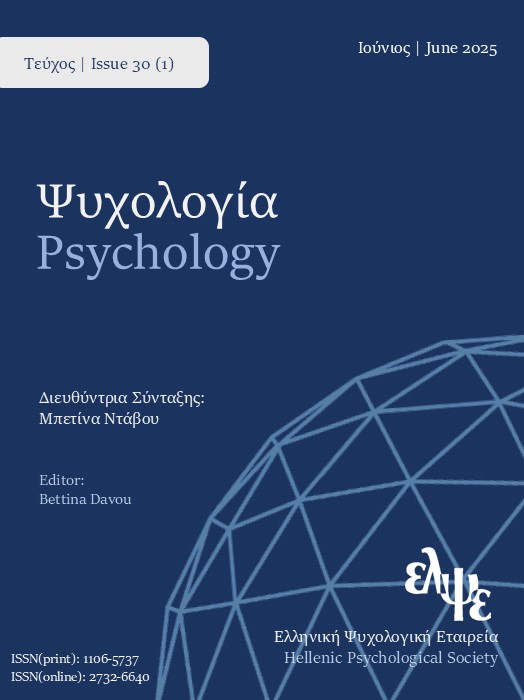Θεραπευτική σχέση: δυναμικές αλληλεπιδράσεις και ο ρόλος του φύλου

Περίληψη
Στο παρόν άρθρο υπογραμμίζεται, κατ’ αρχάς, η σημασία διαφόρων πλευρών της ψυχοθεραπευτικής σχέσης -όπως η θεραπευτική συμμαχία, η συνεργασία, η ενσυναίσθηση, η συμφωνία ως προς τους στόχους-, οι οποίες αποδεδειγμένα επηρεάζουν το θεραπευτικό αποτέλεσμα και συνδέονται σταθερά με την βελτίωση της ψυχικής υγείας του/της θεραπευόμενου/ης, ανεξάρτητα από τις διαφορετικές θεωρητικές προϋποθέσεις και αρχές των ψυχοθεραπευτικών προσεγγίσεων. Από την άλλη πλευρά, αναγνωρίζεται ότι ο προσδιορισμός των ποιοτικών χαρακτηριστικών που συμβάλλουν και επηρεάζουν την ψυχοθεραπευτική σχέση και διαδικασία αποτελεί ένα επίπονο έργο, καθώς εξαρτάται από τα θεραπευτικά όρια αυτής της σχέσης, τα χαρακτηριστικά του/της θεραπευτή/τριας, αλλά και από παράγοντες που σχετίζονται με τον/την θεραπευόμενο/η, όπως οι στάσεις, οι προσδοκίες, τα κίνητρα και η δέσμευσή του/της σε μια διαδικασία αλλαγής. Ένα στοιχείο που φαίνεται ότι χαρακτηρίζει την ταυτότητα κάθε μέλους ξεχωριστά, αλλά και τις δυναμικές διαδικασίες αλληλεπίδρασης της θεραπευτικής δυάδας, είναι το φύλο. Για το λόγο αυτό, στο παρόν άρθρο επισημαίνεται η σημασία του παράγοντα ‘φύλο’ στη διαμόρφωση της επικοινωνίας και της συνεργασίας μεταξύ θεραπευτών/τριών και θεραπευομένων, ενώ διατυπώνεται η θέση ότι η επίγνωση των δυναμικών της έμφυλης ταυτότητας, σε συνδυασμό και με άλλα χαρακτηριστικά, είναι προϋπόθεση μιας αποτελεσματικής και δεοντολογικά ορθής πρακτικής.
Λεπτομέρειες άρθρου
- Πώς να δημιουργήσετε Αναφορές
-
Athanasiades, C. (2021). Θεραπευτική σχέση: δυναμικές αλληλεπιδράσεις και ο ρόλος του φύλου. Ψυχολογία: το περιοδικό της Ελληνικής Ψυχολογικής Εταιρείας, 26(2), 149–155. https://doi.org/10.12681/psy_hps.26863
- Ενότητα
- ΕΙΔΙΚΟ ΑΦΙΕΡΩΜΑ

Αυτή η εργασία είναι αδειοδοτημένη υπό το Creative Commons Attribution-ShareAlike 4.0 International License.
Το περιοδικό ΨΥΧΟΛΟΓΙΑ έχει υιοθετήσει μία πολιτική Platinum open-access. Τα έξοδα υποβολής, επεξεργασίας ή δημοσίευσης των εργασιών καλύπτονται από την Ελληνική Ψυχολογική Εταιρεία. Τα πνευματικά δικαιώματα των δημοσιευμένων εργασιών προστατεύονται από την άδεια 'Creative Commons Attribution-ShareAlike 4.0 International'. Οι Συγγραφείς διατηρούν τα Πνευματικά Δικαιώματα και χορηγούν στο περιοδικό το δικαίωμα της πρώτης δημοσίευσης. Η άδεια αυτή επιτρέπει σε τρίτους, να χρησιμοποιούν την εργασία σε οποιαδήποτε μορφή, με την προϋπόθεση της διατήρησης των διατυπώσεων που προβλέπονται στην άδεια σχετικά με την αναφορά στον αρχικό δημιουργό και την αρχική δημοσίευση στο περιοδικό ΨΥΧΟΛΟΓΙΑ. Επιπλέον, κάθε διανομή της εργασίας οφείλει να γίνεται με τους ίδιους όρους διανομής, δηλαδή με την ίδια άδεια Creative Commons.






